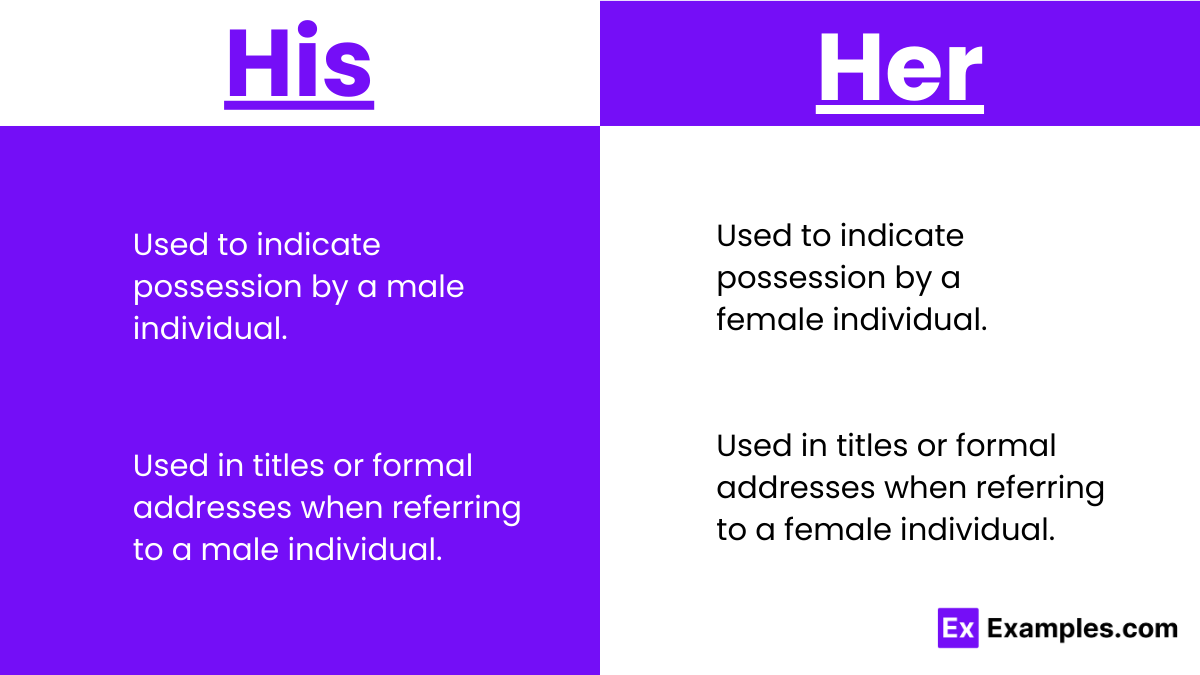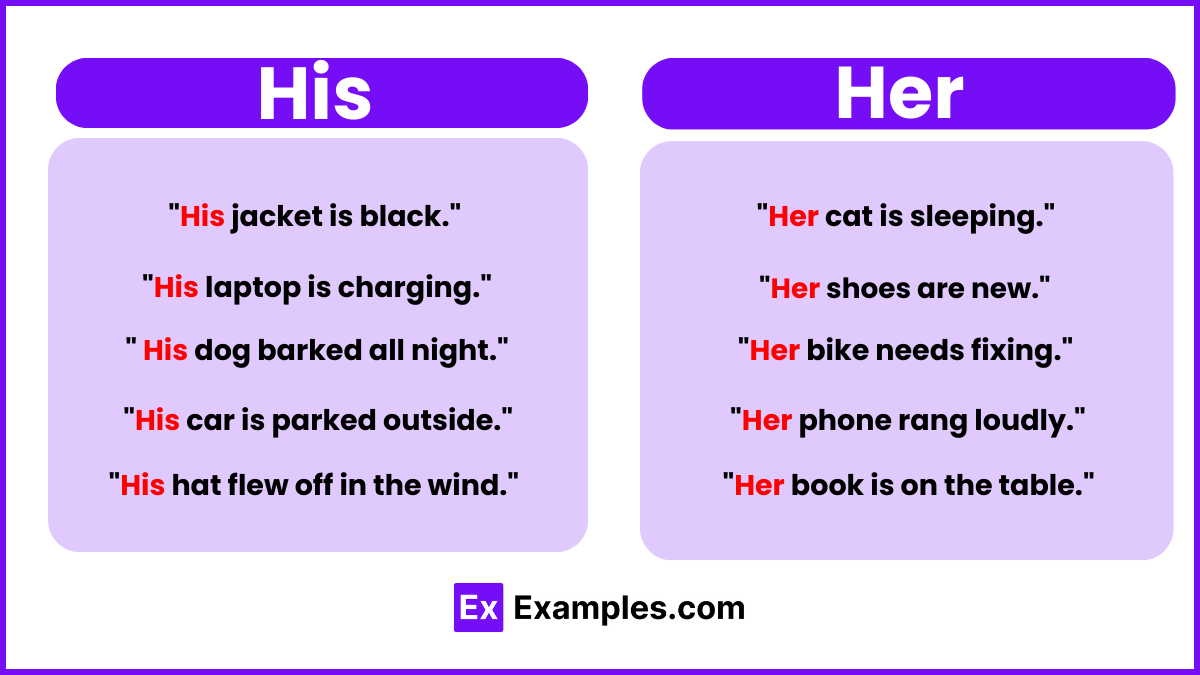His vs Her – Meanings, Differences, Usage, Examples
In everyday language, we often use “his” or “her” to talk about someone’s belongings or actions. But sometimes, it can be confusing to know when to use which. This article will help clear up the confusion by explaining when to use “his” (referring to something belonging to a male) and when to use “her” (referring to something belonging to a female) in different situations. By understanding the differences, we can communicate more clearly and respectfully.
His and Her – Meanings
- His: It signifies possession or association with a male individual. It is a pronoun used to indicate ownership, relationships, or characteristics related to males. Additionally, “his” can also convey attributes, actions, or qualities attributed to men in various contexts, reflecting gender-specific roles and identities.
- Her: It indicates possession or association with a female individual. It is a pronoun used to denote ownership, relationships, or characteristics specifically pertaining to females. Similar to “his,” “her” can also convey attributes, actions, or qualities attributed to women, reflecting gender-specific roles, identities, and experience.
Summary
How to Pronounce His and Her
- His: Pronounced as /hɪz/.
- Her: Pronounced as /hər/.
Differences between His and Her
| Aspect | His | Her |
|---|---|---|
| Gender Specificity | Refers to possession by a male | Refers to possession by a female |
| Grammatical Agreement | Matches masculine nouns | Matches feminine nouns |
| Social and Cultural Implications | Reflects traditional gender roles | Reflects traditional gender roles |
| Possessive Form | Denotes ownership or association | Denotes ownership or association |
| Usage | Used for males | Used for females |
| Pronoun Type | Masculine | Feminine |
| Associated Gender | Male | Female |
Tricks to Remember the Difference between His and Her
- Sound Association: Think of the word “His” starting with the same sound as “him” (which refers to a male), while “Her” starts with the same sound as “her” (which refers to a female).
- Visual Cues: Imagine the letter “H” in “His” as representing the word “Him” (male), and the letter “H” in “Her” as standing for “Her” (female).
- Gender Association: Associate “His” with masculinity and “Her” with femininity. “His” is for males, and “Her” is for females.
- Personalize: Relate the possessive pronouns to people you know or characters from stories. For example, “His” could be linked to a male friend’s possessions, and “Her” to a female friend’s possessions.
When To Use His and Her

Usage of His
- Possessive Form: “His” is used to indicate possession by a male individual.
- Gender-Specific Language: Historically, “his” has been used as the default pronoun when the gender of the individual is unknown or unspecified.
- Titles and Formal Address: “His” is used in titles or formal addresses when referring to a male individual.
Usage of Her
- Possessive Form: “Her” is used to indicate possession by a female individual.
- Gender-Specific Language: “Her” is used to refer to a female individual when their gender is known or specified.
- Titles and Formal Address: “Her” is used in titles or formal addresses when referring to a female individual.
How To Use His and Her
Usage of His
- Direct Object: When “his” is used as a direct object, it refers to the male person or thing receiving the action of the verb.
- Subject of a Verb: When “his” is the subject of a verb, it usually denotes an action being performed by a male.
- After Prepositions: “His” is used after prepositions to show the relationship between a male and other elements in the sentence.
- With Infinitives: When “his” is used with infinitives, it indicates the involvement of a male in the action.
Usage of Her
- Direct Object: When “her” is used as a direct object, it refers to the female person or thing receiving the action of the verb.
- Subject of a Verb: When “her” is the subject of a verb, it usually denotes an action being performed by a female.
- After Prepositions: “Her” is used after prepositions to show the relationship between a female and other elements in the sentence.
- With Infinitives: Infinitives are the base form of a verb preceded by “to”. When “her” is used with infinitives, it indicates the involvement of a female in the action.
His and Her – Examples

His Examples
- His car is parked in the driveway.
- He enjoys playing basketball with his friends.
- His favorite book is “To Kill a Mockingbird.”
- He wore his best suit to the job interview.
- His dog is named Max.
Her Examples
- Her bicycle is red with white stripes.
- She loves baking cookies in her spare time.
- Her dream vacation is to visit Paris.
- She keeps her keys in her purse.
- Her cat enjoys lounging in the sun.
Exercises
- She forgot ____ keys at home.
- He is carrying ____ backpack.
- The teacher praised ____ for excellent work.
- ____ dog is very playful.
- The baby is holding ____ mother’s hand.
Answers
- her
- his
- her
- his
- her
FAQ’S
Is “His” for a Boy or Girl?
“His” is typically used for boys or males. It indicates possession or ownership by a male individual.
Is “Her” Used for a Girl or Boy?
“Her” is commonly used for girls or females. It denotes possession or ownership by a female individual.
Can We Use His for Things?
Yes, his can be used for inanimate objects or things when indicating possession by a male.
Can I Use “His” for Girl?
Typically, “his” is not used for girls. Use “her” to indicate possession by a female. For example, “She wore her favorite dress.”


